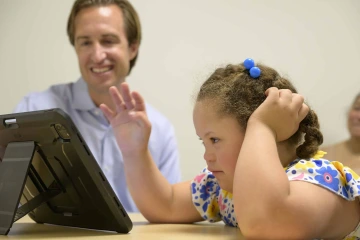Dan Combs helps young Down syndrome patients get good ZZZs
Assistant professor focuses on improving sleep as the first step toward a better quality of life for his patients and their families.

Dan Combs, MD, has dedicated his career to helping children with Down syndrome. His research focuses on the impact of sleep apnea and other disorders on youngsters with the chromosomal condition.
Photo by Kris Hanning, U of A Health Sciences Office of Communications
Every time the Powerball jackpot hits $500 million, Dan Combs, MD, snags a ticket.
He’s got big plans.

Dan Combs, MD, loves working with kids because of their high energy, and it’s a chance to make a lifelong impact on healthy habits.
Photo by Kris Hanning, U of A Health Sciences Office of Communications
“I’ve thought about what I would do with the money, and I would keep half and use the other half to start a sleep research foundation,” said Combs, an assistant professor in pediatrics and sleep medicine at the University of Arizona College of Medicine – Tucson’s Department of Medicine. “That way, I could basically have people do the research I want to see done without worrying about all of the other stuff, like getting grants and writing the reports.”
Notice that he didn’t say he’d quit his day job. Not a chance.
Combs, associate program director for the sleep medicine fellowship as well as assistant director for scholarly projects, loves his work. Those lottery winnings would just let him focus on streamlining his research, which focuses on the impact of sleep apnea and other disorders on children with Down syndrome.
October is National Down Syndrome Awareness Month, and Combs has dedicated his career to helping those diagnosed with the most common chromosomal condition in the United States. Each year, about 5,700 babies are born with Down syndrome in this country alone.
Sound sleep
People with the condition are much more likely to have sleep apnea, specifically obstructive sleep apnea, which causes breathing to be interrupted while sleeping because the airway collapses. It’s the most common type of sleep apnea and one that affects those with Down syndrome because of their low muscle tone. After a promising initial study, Combs has a larger, follow-up study underway to see how a combination of atomoxetine, a nonstimulant ADHD medication, and oxybutynin, which is used to treat overactive bladders, can help keep airways open.
“If you look at the consequences of obstructive sleep apnea – mood, behavior and cognitive performance are all really impacted, and that's obviously a very big deal,” Combs said. “If you already have an intellectual disability, that extra impairment from sleep apnea can really be the difference between having a job and independence versus needing a caretaker. It can really make a huge difference.”
Any parent with a child who has trouble sleeping will tell you how disruptive that can be for the whole family.
“Parents will come in because they’re at the end of their rope because their kids can’t sleep,” said Combs.
Sometimes, the solution is behavioral, such as the case for a 10-year-old patient Combs saw. The boy had no underlying medical conditions but struggled to fall asleep every night. His parents were putting him to bed at 7 p.m., which was too early as he got older. Combs counseled them to put their son to bed at 9 p.m. and then gradually move up bedtime by 10 minutes each night until it was closer to a more reasonable 8 p.m. They came back three months later and reported their son was sleeping fine.
It's that kind of direct impact that brought Combs to pediatric sleep medicine in the first place.
Direct impact
By his own admission, Combs, who spent middle and high school in Mesa, Arizona, was always an “I want to be a doctor when I grow up” kind of guy. As a science-loving kid, the analytical aspects appealed to him. So did working with and helping people.

Dan Combs, seen here with patient Bellamy Coleman, said he enjoys seeing the world through children’s eyes.
Photo by Kris Hanning, U of A Health Sciences Office of Communications
It was also pretty much a given that he’d attend the University of Arizona. Both his parents and two older brothers are alumni.
Combs zeroed in on pediatrics as a resident.
“I think kids are just fun,” said Combs. “They just bring energy.”
He knows this not only professionally but personally, too, as the father of a 10-year-old daughter and 7-year-old son who, quite literally, run him around – both compete in 5Ks. Combs, who was a triathlete before kids, said he’s had to boost his running so he can keep up with their anticipated progress.
Initially, Combs thought he’d practice developmental pediatrics. Then he found his niche in sleep medicine.
“I think anyone can identify with if you sleep better, you're happier, you're smarter, right? Life is better,” he said.
And it’s not just watching his patients grow that brings him enjoyment. Combs said he appreciates working with “a lot of really awesome parents who are amazing advocates for their kids. It’s really rewarding to see.”
Of course, it can also be challenging to work with young kids who struggle to find the right words to describe their symptoms.
“It’s almost like a puzzle to solve together with the patient and their family,” Combs said.
But Combs likes trying to see things from a child’s perspective.
“I enjoy trying to get an understanding of how they see the world,” he said.
It’s also a population where you can really make a difference.
“They’re young. There’s a lot ahead of them,” Combs said. “I think the impact you can make is huge. It’s a lifetime impact. If you’re changing something at 5 years old, that’s a change that sticks around for 70, 80, 90 years.”

